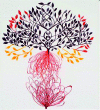Visual art in hospitals: case studies and review of the evidence
- PMID: 21127332
- PMCID: PMC2996524
- DOI: 10.1258/jrsm.2010.100256
Visual art in hospitals: case studies and review of the evidence
Abstract
In 2006 a Department of Health Working Group on Arts and Health reported that the arts have 'a clear contribution to make and offer major opportunities in the delivery of better health, wellbeing and improved experience for patients, service users and staff alike'. In this review we examine the evidence underpinning this statement and evaluate the visual art of three of Scotland's newest hospitals: the Royal Infirmary of Edinburgh, the new Stobhill Hospital, and the new Victoria Infirmary in Glasgow. We conclude that art in hospitals is generally viewed positively by both patients and staff, but that the quality of the evidence is not uniformly high. Effects may be mediated by psychological responses to colour hue, brightness and saturation. Colours that elicit high levels of pleasure with low levels of arousal are most likely to induce a state of calm, while those causing displeasure and high levels of arousal may provoke anxiety. The fact that patients frequently express a preference for landscape and nature scenes is consistent with this observation and with evolutionary psychological theories which predict positive emotional responses to flourishing natural environments. Contrary to a view which may prevail among some contemporary artists, patients who are ill or stressed about their health may not always be comforted by abstract art, preferring the positive distraction and state of calm created by the blues and greens of landscape and nature scenes instead.
Figures








References
-
- Schirmer K. News. J Roy Soc Promot Health 2006;126:99–108
-
- Ulrich RS, Lunden O. Effects of exposure to nature and abstract pictures on patients recovery from heart surgery. Psychophysiology 1993: S1: 7
-
- Tse MM, Ng JK, Chung JW, Wong TK. The effect of visual stimuli on pain threshold and tolerance. J Clin Nurs 2002; 11: 462–9 - PubMed
-
- Diette GB, Lechtzin N, Haponik E, Devrotes A, Rubin HR. Distraction therapy with nature sights and sounds reduces pain during flexible bronchoscopy: a complementary approach to routine analgesia. Chest 2003;123:941–8 - PubMed
-
- Staricoff R, Loppert S. Integrating the arts into healthcare: can we effect clinical outcomes? In: Kirklin D, Richardson R, eds. The Healing Environment: Without and Within. London: RCP; 2003. pp. 63–79
Publication types
MeSH terms
LinkOut - more resources
Full Text Sources
Medical

